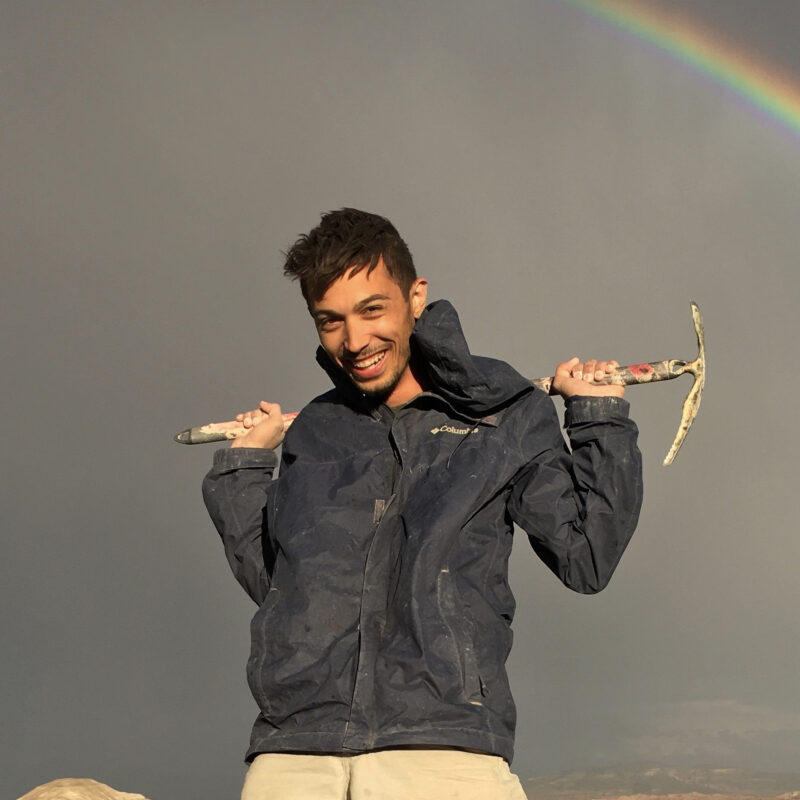
I am a final-year Ph.D. student at NC State in the Department of Biological Sciences and a researcher in the Paleontology Lab at the NCMNS. My advisor is Dr. Lindsay Zanno. I received my Master’s in Biology from NC State in 2018 under the advisement of Dr. Lindsay Zanno, and my Bachelor’s in Geology and Paleontology from Appalachian State University in 2016 under the advisement of Dr. Andy Heckert. I have a decade of field experience across Montana, Utah, Arizona, and New Mexico, managing fossil quarry excavations, mapping, prospecting, and organizing operational logistics.
I am a member of the Society of Vertebrate Paleontology. I am a research assistant for North Carolina’s new Dueling Dinosaurs Experience and the content creator for a new public science program called Cretaceous Creatures, aimed at middle schools across North Carolina (CC website). I am technically proficient in the 3D modeling and visualization software, Blender, the CT segmentation software Avizo, and I am a trained operator on one of the world’s highest resolution CT scanners.
It is easy to use, fun to operate and finishes analyses in record time.
I am also proficient in Photogrammetry, 3D laser scanning, 3D resin printing, molding and casting, Keyence digital microscopy, Adobe Premiere video production software, and Bayesian phylogenetic statistical analyses.
For fun, I like trying new things and having novel experiences. I like visiting ancient ruins, eating spicy foods, investing in the stock market, playing volleyball and piano, hiking the deserts of the Earth with my fiancé, going to art museums, 3D scanning artifacts, learning new software, making new friends, meeting new people, moving fast, and working hard.
What instruments are you using for your research and why do you like them?
I am using the Zeiss Xradia Nano-CT scanner to look inside the bones and body parts of long-extinct animals such as dinosaurs, early mammals, and the Megalodon shark. I like the Zeiss nano-CT because it is a remarkably powerful instrument, second only to a synchrotron, capable of rendering incredibly high-resolution/high-fidelity images of some of the smallest biological specimens. It is easy to use, fun to operate and finishes analyses in record time.
What have you been researching and how is it impacting the community?
During the age of the dinosaurs a spectacular array of plant eating dinosaurs evolved. Some of these include elaborate sailed-backed stegosaurs, horn & frilled ceratopsians, dome-headed pachycephalosaurs, nose-crested hadrosaurs, and giant armored ankylosaurs. However, this wide diversity of herbivores evolved from a primitive group of small-bodied, bipedal dinosaurs, which is what I study. These dinosaurs are often lumped into designators such as neornithischia, Cerapoda, basal Ornithopoda, or early diverging Ornithischia. This multitude of descriptors for such a broad range of animals is due in part to the inconsistencies between hypotheses regarding their interrelationships. In other words, this part of the dinosaur family tree currently looks more like a comb, rather than a series of bifurcating branches along a larger stem; a knowledge gap that hampers our ability to pursue broader questions relating to ornithischian dinosaur ecology, biogeography, evolutionary rates, diversification, and morphological trends. My dissertation is focused on describing a remarkable new collection of skeletons from a new species of these neornithischian dinosaurs we collected from the Early Cretaceous of central Utah.
This is one of the largest collections of small-bodied, early diverging, ornithischians (cranial and postcranial) known the world over, comprised of individuals of multiple age classes, and potential sexes. My work will establish a robust phylogenetic database of the group and their closely related kin, will permit a detailed exploration of changes during growth, and will characterize the range of intraspecific and sexual variation exhibited across the clade. Additionally, these specimens are found buried together in odd, meter-sized bundles. This preservation may indicate fossorial behavior, a hypothesis supported by my previous histological analyses as well as other studies on closely related species. Taken together, these newly discovered specimens and their unusual mode of preservation, provide a rare opportunity to test a variety of novel paleobiological and evolutionary questions.
My other research is the content creator for a new public science program called Cretaceous Creatures, launched this year to serve hundreds of NC middle schools (CC website). I used the Zeiss Nano CT scanner to produce most of the models used in this public science project.
What have you learned from your experience at AIF?
Slow is Smooth, Smooth is Fast
Is there a staff member at AIF that has helped you?
Dr. Ruksana Baby and previously Dr. Anton Jansson taught me everything I needed to know about operating the Zeiss.